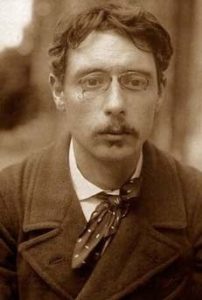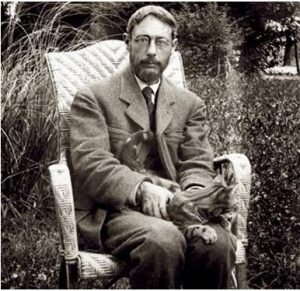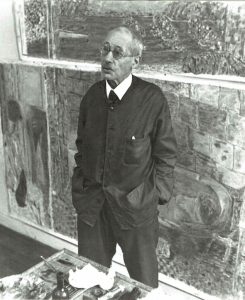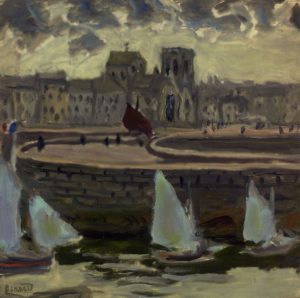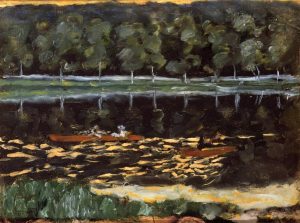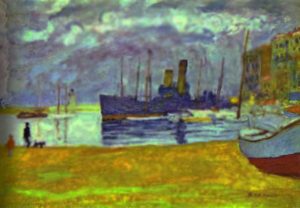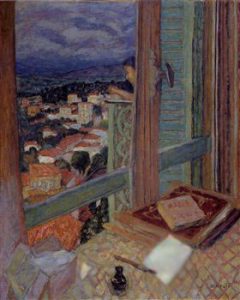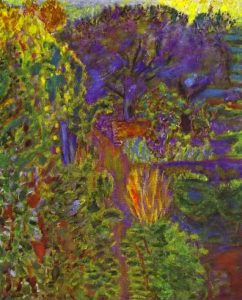Pierre Bonnard was born the 3rd of October in 1867 in Fontenay-aux-Roses, near Paris.
1867 - 1947
Pierre Bonnard

description
A French painter, graphic artist and designer, who entered the history of fine art as one of the brightest colourists of the late 19th – the first half of the 20th centuries.
The artist was born into the family of a high-ranking official. Received a legal education, on which his parents insisted. Then he received an art education.
Bonnard belongs to the second generation of French Impressionists. Together with J. Vuillard, P. Serusier and M. Denis, Bonnard organized the famous group of artists named “Nabis”, whose members, admiring the art of Japanese engraving, sought to simplify painting, working with planes of pure colour and avoiding the randomness inherent in the first wave of Impressionism. At the end of his life, Pierre Bonnard departed from the fundamental principles of “Nabis” and turned to more saturated colour combinations, creating exquisite colourful compositions. The artist painted landscapes, still lifes, interiors in an easy impressionistic manner.
Key ideas:
– The representative of the late Impressionism, Pierre Bonnard often criticized his companions for the fuzzy composition and the naturalism of colour in their canvases. The artist has always sought to create something new, to find special artistic means, which would convey the reality as expressively as possible.
– The aesthetics of the Nabis group, at the origins of which Bonnard stood, proclaimed the absolute power of the colour principle, decorativeness, a return to the simple creation of the people, stylization and the flat-line representation of forms. “Nabists” was greatly influenced by Japanese engraving, which is the most clearly shown in the works of Bonnard.
– The canvases of Pierre Bonnard were highly appreciated by his contemporaries, who called him “the most picturesque painter.” The artist masterfully worked with colour, his paintings in soft, subdued tones depict modern interiors, Mediterranean and urban landscapes, scenes from everyday life.
– Bonnard paid particular attention to the inner, intimate life of a woman, depicting a nude model while bathing in the bathroom, relaxing in the house, or her daily activities. Bonnar and several other participants of the creative group “Nabis” are often called “intimists” for their desire to poetize the everyday reality.
– A translucent haze surrounds the objects of his paintings, and the combinations of colours are often whimsical and intricate. His favourite themes are nature and naked female models; many of his paintings are devoted to the street life of Paris.
– The main thing in the artist’s later works was not an image, but a light that fills the whole picture. Colour combinations and contrasts – this is the main theme of the late works of Bonnard, no matter what movement and style they relate to. “Our God is light. Once upon a time, you will understand what this means,” he wrote in a letter to a young artist.
1867
1888
1891
1893
1896
1905
1908
1925
1926
1946
1947
The birth of the artist
He studied at the School of Fine Arts
He studied at the School of Fine Arts, where the Nabis group (from the Jewish nebiim meaning “prophets”) was formed, uniting young artists who were looking for new methods in the art.
He began to exhibit his paintings at the Salon of Independent
He began to exhibit his paintings at the Salon of Independent. At that time, the artist’s work became more and more diverse. He painted theatrical posters, painted screens and scenery, illustrated books, worked on prints and lithographs. His first poster, commissioned by France-Champagne and pasted on the walls of Paris, caused exceptionally positive reviews.
Met Marie Boursin
Met Marie Boursin, also known as Martha. She soon became the main model of the artist, a muse that inspired him to create numerous nu, among which there are real masterpieces. The couple lived together for more than 30 years.
The first personal exhibition of the artist
The first personal exhibition of the artist took place. He proceeded to design P. Nansen’s book “Maria”, creating unique illustrations.
He painted many landscapes, everyday scenes
Together with Nabist E. Vuillard, he went on a trip to Europe, as well as to Algeria and Tunisia. He painted many landscapes, everyday scenes.
The period of "intimism" finished
The period of “intimism” finished. The artist changed his manner, referring to the scenery. His palette became more saturated and refined.
Bought a house on the Cote d'Azur
Bought a house on the Cote d’Azur, in Cannes. He worked a lot and worked energetically, often returning to his favorite topic – “nude.”
He was elected a member of the jury of the Carnegie Prize and visited the United States in this post
He was elected a member of the jury of the Carnegie Prize and visited the United States in this post.
He arranged a significant retrospective exhibition of his works
After experiencing the German occupation, he arranged a significant retrospective exhibition of his works of different periods.
The death of the artist
He died on the 23rd of January in 1947 in Le Cannet.


